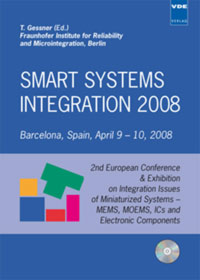Monolithic integration of MEMS resonators in a 0.35µm CMOS technology for gravimetric sensor and radiofrequency applications
Conference: Smart Systems Integration 2008 - 2nd European Conference & Exhibition on Integration Issues of Miniaturized Systems - MOMS, MOEMS, ICS and Electronic Components
04/09/2008 - 04/10/2008 at Barcelona, Spain
Proceedings: Smart Systems Integration 2008
Pages: 8Language: englishTyp: PDF
Personal VDE Members are entitled to a 10% discount on this title
Authors:
Abadal, Gabriel; Torres, Francesc; López, Joan Lluis; Uranga, Arantxa; Barniol, Núria (Departament d’Enginyeria Electrònica, Universitat Autonòma de Barcelona, Bellaterra, Barcelona, SPAIN)
Teva, Jordi (MIC-Institut for Mikro- og Nanoteknologi DTU. Kgs Lyngby, DENMARK)
Verd, Jaume (Departament de Física, Universitat de les Illes Balears, Palma, SPAIN)
Esteve, Jaume; Pérez-Murano, Francesc (Institut de Microelectrònica de Barcelona, CNM-CSIC, Bellaterra, Barccelona, SPAIN)
Abstract:
Microelectromechanical systems (MEMS) technology started at the end of 70’s and early 80’s as an extension of microelectronics technology, which added to processing and memory functionalities of Integrated Circuits (IC) sensor and actuation functionalities that allows the IC to interact with the environment. Since then, and especially in the last decade, MEMS technology has reached a maturity level high enough to introduce products into a continuously growing market. One of the key points of this evolution is the possibility to integrate both MEMS elements together with CMOS circuitry. The most important strategies to integrate MEMS with CMOS circuitry (MEMS-CMOS) are monolithic integration and hybrid integration. The advantages of monolithic integration are integration area compactness, interconnection parasitics minimization and integration costs reduction, but the main drawback is that structural materials and processes for MEMS elements fabrication are strongly limited by CMOS technology restrictions. On the other hand, hybrid integration relaxes these MEMS structural materials restrictions, but increases integration costs due to the complexity of the assembling processes.


